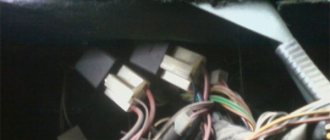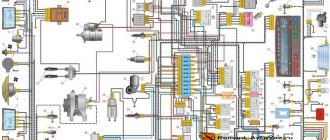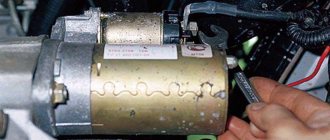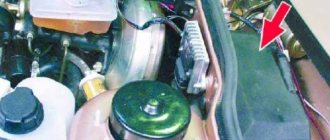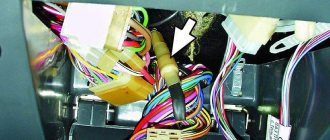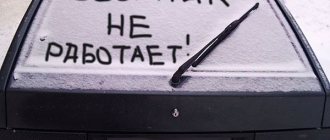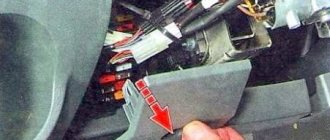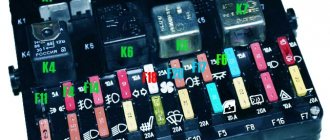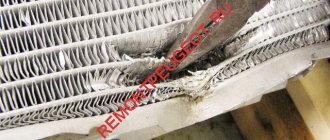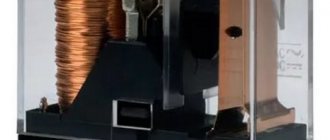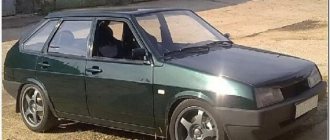One of the key components of the electrical circuit of a VAZ 2105 car is the fuse box. Many problems with electrical equipment that arise during the operation of a vehicle are associated with this particular unit. Car enthusiasts, as a rule, carry out maintenance and diagnostics of faults in the fuse box on their own.
- Block under the hood
Table: which fuse is responsible for what - How to remove the mounting block
- Repair of mounting block
- Replacing a burnt track
Video: how to repair a blown fuse box track
- How to identify a blown fuse
VAZ 2105 fuses
The purpose of the fuses used in the VAZ 2105 car is no different from the function of any other fuses - protecting electrical circuits from short circuits, sudden power surges and other abnormal operating conditions. VAZ 2105 fuses, which can be cylindrical or plug-in type, are mounted on the same block with the relay. The mounting block can be located under the hood or inside the car .
The operation of the fuse is based on Ohm's law, known from school: if the resistance in any part of the electrical circuit decreases, this leads to an increase in current. If the current exceeds the permissible value provided for a given section of the circuit, the fuse blows, thereby protecting more important electrical appliances from failure.
How to replace fuses yourself
If a breakdown is detected in the fuses, then the best option would be to immediately disassemble the unit and replace the failed component. The process of replacing fuses is quite simple and does not require special skills. After all, it’s enough just to remove the old fuse and install a new one (the price of new fuses is quite reasonable and fluctuates around 50-100 rubles for 10 pieces).
If the decision is made to replace the fuses, it is necessary to replace everything, since if you leave the old ones and install several new ones, a voltage drop may occur and all the fuses will blow. It is also necessary to fully ensure that their location is correct according to the diagram and output current.
Based on all of the above, we can conclude that the fuses in the domestically produced VAZ-2104 car are quite an important component, which literally saves the entire car from any unwanted breakdown, and in which case it protects its owner from significant problems.
It should also be said that the VAZ-2104 and its fuses are practically no different from other models, except for the location. Every car, be it a modern sports car or an old classic, needs careful care. In this regard, in order to avoid serious breakdowns, maintenance should be carried out in a timely manner and even the most minor breakdowns should not be neglected.
Mounting block in the cabin
In the first VAZ 2105 models, the fuse box was located inside the car. Such a block can still be seen today in some “fives” under the instrument panel next to the left door. Each of the fuses on the block located in the passenger compartment is responsible for the same section of the electrical circuit as the corresponding fuse on the block located under the hood.
How to identify a blown fuse
If problems arise with any group of electrical equipment in the car, the likelihood that the problem is in the fuse is high, but not one hundred percent. To make sure that a fuse has failed, sometimes an external inspection is enough: if there are burnt marks on its body, most likely the fuse has burned out. This method of checking is quite primitive, and in this case it is better to use a multimeter, which allows you to diagnose the malfunction:
- by voltage;
- by resistance.
In the first case it is necessary:
- Set the multimeter to voltage measurement mode.
- Turn on the circuit being tested, such as lighting, stove, etc.
- Check the presence of voltage at the fuse terminals. If there is no voltage at one of the terminals, the fuse must be replaced.
In the second case, the multimeter is switched to resistance measurement mode, after which the tips of the device are connected to the removed fuse. If the resistance value is close to zero, the fuse requires replacement.
If the resistance value is close to zero, the fuse requires replacement
Unit dismantling and repair
The fuse box located in the passenger compartment is removed in the same sequence as that installed under the hood. It is necessary to unscrew the fasteners, remove the connectors and remove the unit. Just as in the case of the block located under the hood, repairing the mounting block installed in the cabin involves replacing fuses and restoring the tracks.
If the fuse blows on the road and you don’t have a spare at hand, you can replace it with a wire. But at the first opportunity, the wire must be removed and a rated fuse installed instead . The fuse location diagram is usually shown on the inside of the mounting block cover.
It should be remembered that there are several types of mounting blocks that do not differ from each other in appearance. The differences lie in the wiring of the tracks. When replacing a block, you need to make sure that the markings of the old and new blocks match. Otherwise, the electrical equipment will not work correctly.
I changed the mounting block in the VAZ 2105 about six months ago. When I changed it, I didn’t know that there were several types. The sellers at the car market claimed that there was only one type, and since my old one was completely falling apart, I had to take what I had. Two problems immediately appeared with the new unit: the wipers stopped working (this problem was solved by throwing a jumper from the first fuse to the second). The second problem (and the most important) is that when the car just sits with the engine turned off, it drains the battery (the charging wire, if it matters, is inserted into the 3rd slot, 1st socket, I don’t know how to say it differently, I have almost no knowledge of auto electrics at all. Completely charged in about 8 hours, it discharges to 0. The third problem (not so important) - the turn signal indicators disappeared. I went to an auto electrician, he just threw up his hands, looked at the panel and could not do anything. I threw out the old panel, as it was almost completely crumbled, not I knew that such a problem would happen, so I have nothing to compare it with.
A pedestrian
https://www.semerkainfo.ru/forum/viewtopic.php?t=2040&start=100
Old style fuse box
Old style mounting blocks use cylindrical (finger) fuses, which are installed in special spring-loaded connectors. Such connectors are not reliable and durable, which is why they cause a lot of complaints from car enthusiasts.
The old-style VAZ 2105 mounting block uses cylindrical fuses
Each of the 17 fuses located on the old-style mounting block is responsible for the same groups of electricity consumers as the corresponding fuses on the new-style block (see table above). The only difference is the rated current for which the cylindrical fuses are designed. Each plug fuse (on a new type block) has a rated current:
- 10 A corresponds to a finger fuse with a rated current of 8 A on an old-style unit;
- 20 A - 16 A;
- 7.5 A - 8 A.
Maintenance and repair of the VAZ 2105 fuse box in most cases does not cause difficulties for car enthusiasts. To independently determine the malfunction of the mounting block and fix it, even a little driving experience is enough. For reliable operation of electrical equipment, it is important to use fuses with the parameters specified in the technical documentation.
Feature in the fuse circuit
The specificity of the operation of fuses lies in the fact that they work according to a circuit distribution of functions, or in simple words, certain fuses are responsible for protecting one or another part of the car, and each of them is designated by its own unique number. Here is a small list of fuses and their areas of responsibility.
| Fuse designations | Protected Circuits |
| F1 | Responsible for the cigarette lighter, heating electric generator, rear lights, rear window heating relay. |
| F12 | Responsible for the windshield wiper relay. |
| F3, F4, | Backup (for example, fuses for heated seats). |
| F5 | Low beam fuse on the left side. |
| F6 | Low beam fuse on the right side. |
| F7 | Responsible for some relays and audio signals. |
| F8 | Responsible for emergency and turn signals. |
| F9 | Fuse for battery charging, fog lights and generator operation. |
| F10 | Responsible for the rear lights. |
| F 14, F 15 | Front and rear dimensions. |
These are the main fuses in the VAZ 2104, as they are responsible for the most important systems of any car. In addition to fuses, in a car with an injection engine it is possible to install a central lock.
As for the relays, in the VAZ-2104 they are responsible for the operation of the fuel pump, the cooling fan and the entire unswitched power supply circuit of the engine controller. Additionally, fuses for power windows can be installed in the panel.
Additional items
Under the hood
Additional headlight wiper fuses (2A rating) protect the motor windings. They are located on the supply wires next to the gearmotors.
The starter activation relay 113.3747 or 90.3747-10 is located in the engine compartment on the right mudguard.
In the cabin
The windshield wiper relay (PC-514) is mounted under the panel on the left under the trim.
The ignition relay and the hazard warning and turn signal relays are installed on the front panel behind the instrument panel. The ignition relay (113.3747-10 or 90.3747-10) and the hazard warning and turn signal relays (23.3747 or 231.3747) have a bracket for direct mounting on the body.
The fog lamp fuse is located in the gear shift compartment, not far from the radio.
Recommendations for use
- Never install fuses that are designed for high current loads. In the event of a short circuit in the electrical circuit, not only the equipment it protects will suffer, but the wiring will also catch fire.
- Very often, on a VAZ 2105 with a carburetor, some equipment stops working due to the fact that the fuse is not seated tightly in the block, which leads to loss of contact. To do this, it needs to be installed more tightly. If this is not done, the place where it is installed will begin to heat up and, as a result, the part of the block adjacent to it may melt. In such a situation, it will need to be replaced.
Sorry, there are no surveys available at this time.
Wiper relay functions
Windshield wipers operate thanks to an electric motor that supplies 12V voltage. However, this is too much power, requiring a significant amount of direct current. It is to reduce the direct current indicator that a relay of the RS-514 format is installed in the electrical circuit, which regulates the frequency of movement of the wipers. The VAZ-2107 car is equipped with 2 options for moving the windshield wipers - one is possible without a break, the other has a pause of 4 seconds.
The windshield wiper relay on the windshield in the VAZ-2107, in particular where it is located, is of interest to many car enthusiasts, otherwise in some cases it becomes impossible to repair the windshield wipers. So, the mechanism is located under the dashboard on the left with a focus on the driver’s seat. The fasteners are made directly to the body of the VAZ-2107; 2 screws located under the upholstery act as reliable fasteners. When examining the relay, you will notice that there is a wiring coming to it, at the end of which there is a plug for connecting the device.
The connector, which is responsible for connecting the plug, is located on the instrument panel near the headlight hydrocorrector control. To carry out repair work, you need to remove it from below. If you doubt that you have selected the correct plug, unplug it and check that the windshield wipers are working.
If the lever is in position 1, but the wiper does not function, the mechanism is not turned on.
Old style block
With the exception of very ancient and rare first copies, switching units, also called black boxes, for the VAZ 2105 were mounted outside the engine panel on the right, and wiring from the engine compartment to the control units passed through them. Initially, cylindrical fuses were used, like the first VAZs, of two ratings, 8A and 16A.
All seventeen fusible links stood in a row at the front wall of the case. The location and distribution of loads was also similar to its predecessors.
| Serial number | Denomination, A | Connected Circuits |
| 1 | 8 | Reversing lights, heater, glass heating switching |
| 2 | 8 | Pumps and wipers |
| 3 | 8 | Reserve |
| 4 | 8 | Reserve |
| 5 | 16 | Glass heating threads |
| 6 | 8 | Cigarette lighter circuit and additional connector |
| 7 | 16 | Horn and electric cooling fan |
| 8 | 8 | Turn signal and emergency |
| 9 | 8 | Fog lights and starting the generator |
| 10 | 8 | Instruments, visor and turn alarms |
| 11 | 8 | Brake light circuit, interior light |
| 12 | 8 | Far right, cleaning headlights |
| 13 | 8 | Far left, far control |
| 14 | 8 | Dimensions left front and right rear, size alarm, license plate illumination, engine compartment light |
| 15 | 8 | Dimensions on the right front and left rear, lighting of the dashboard, cigarette lighter and glove box |
| 16 | 8 | Middle right, headlight cleaning switch |
| 17 | 8 | Middle left |
The fastening of outdated type fuses was not reliable, which was in no way compensated by the simplicity and clarity of their replacement. Therefore, the design was soon changed.
Starter replacement
Using a 10mm wrench, unscrew the bolt of the lower fastening of the starter heat shield (it is located in a hard-to-reach place)…
...and take it out.
We remove the hose from the warm air intake and, using a 13mm wrench, first unscrew one nut on the top fastening of the shield,...
...then the second one (the nut is located under the air intake).
We remove the shield.
Using a 13mm wrench, unscrew the two upper bolts securing the starter to the clutch housing...
...and use a 13mm socket from the bottom of the car to unscrew the lower mounting bolt.
Moving the starter forward, disconnect the block from the traction relay output (for clarity, the cooling system hose has been removed).
Using a “13” wrench, unscrew the nut securing the wire connecting the terminal of the starter traction relay to the “+” terminal of the battery.
We take the starter up between the exhaust pipe and the clutch housing.
The new starter must be installed in the reverse order of removal. When connecting the wires, we make sure that the power wire of the traction relay is securely fastened, because With an installed starter, it is very difficult to connect a loose wire.
Block under the hood
In most VAZ 2105 models (with the exception of the very early models), the fuse box is moved from the cab under the mask: you can see it under the windshield, opposite the passenger seat.
Table: which fuse is responsible for what
In addition to the fuses listed in the table, the set includes 4 spare fuses - F18-F21. All fuses are painted:
- 7.5 a - brown;
- 10A - red;
- 16A - blue;
- 20a - yellow.
How to remove the mounting block
To remove the fuse block you need a 10mm socket key. To delete a block:
- Disconnect the negative battery terminal.
- Unplug the plugs in the living room.
The plug connectors in both the passenger compartment and the engine mask are color coded. The internal receptacles in the fuse box are also marked with the same color (colored wheels). This is done so that when installing the unit you do not make a mistake about which connector is connected to. If there is no color mark on the block, make them independently (such as a marker). A new or repaired device should be installed in the reverse order of disassembly.
Fuse and relay box
The main block with fuses and relays is located under the hood and can be made in 2 versions (old and new). The current diagram will be printed on the block cover.
Option 1
Scheme
Option 2
Installed on cars of early production years, here the fuses are cylindrical.
Scheme
Description
Circuit breakers
| 1 | 8/10A Heater motor Reversing light lamps Rear window heating switch on Rear window heating switch relay (winding) Rear window wiper motor (2104) Rear window washer pump motor (2104) |
| 2 | 8/10A Windshield wiper and washer motor Headlight wiper and washer motor Windshield wiper relay Headlight wiper and washer relay |
| 3 | 8/10A Reserve |
| 4 | 8/10A Reserve |
| 5 | 16/20A Rear window heating element and heating relay |
| 6 | 8/10A Cigarette lighter Socket for portable lamp Clock |
| 7 | 16/20A Sound signals Signal relay Electric radiator cooling fan relay (contacts) Radiator cooling fan electric motor |
| 8 | 8/10A Hazard switch with warning lamp Relay-breaker for direction indicators and hazard lights Turn signal indicator (in hazard mode) Turn indicators (in hazard mode) |
| 9 | 8/10A Generator Voltage Regulator |
| 9 | 8/7.5A Rear fog lamps and their indicator |
| 10 | 8/10A Turn signals (in turn signal mode) Relay - turn signal switch Turn signal indicator Pneumatic valve control system Tachometer Fuel gauge Fuel reserve indicator Parking brake indicator Insufficient oil pressure indicator in the engine lubrication system Coolant temperature indicator Voltmeter Service brake emergency indicator systems Battery charge indicator Carburetor air damper closed indicator Electric fan relay (winding) Electric fan thermal switch Generator excitation winding (generator 37.3701) |
| 11 | 8/10A Interior lamp Brake lamp Luggage compartment lamp |
| 12 | 8/10A High beam headlights (right headlight) Relay for windshield wipers and headlight washers (relay coil) |
| 13 | 8/10A High beam headlights (left headlight) High beam indicator |
| 14 | 8/10A Front side light (left headlight) Rear side light (right light) License plate lights Engine compartment lamp Side light indicator |
| 15 | 8/10A Front side light (right headlight) Rear side light (left light) Cigarette lighter lamp Instrument lighting lamp Glove box lighting lamp Clock (lighting lamp) |
| 16 | 8/10A Low beam headlights (right headlight unit) Relay for windshield wipers and headlight washers (relay coil) |
| 17 | 8/10A Low beam headlights (left block headlight) |
| 18 | Spare |
| 19 | Spare |
| 20 | Spare |
| 21 | Spare |
The cigarette lighter is controlled by fuse number 6 at 8 or 10A.
Relay
| K1 | Relay for turning on the heated rear window (904.3747-10 / 2105 -3747210-18, 2107 -3747210-12) | ||
| K2 | Headlight cleaner and washer relay (904.3747 / 2105 -3747210-08, 2107 -3747210-02) | ||
| K3 | Relay for turning on sound signals (904.3747-10 / 2105 -3747210-18, 2107 -3747210-12) | ||
| K4 | Relay for turning on the electric cooling fan (not used since 2000) (904.3747-10 / 2105 -3747210-18, 2107 -3747210-12) | ||
| K5 | Relay for high beam headlights (904.3747-10 / 2105 -3747210-18, 2107 -3747210-12) | ||
| K6 | Relay for low beam headlights (904.3747-10 / 2105 -3747210-18, 2107 -3747210-12) | ||

